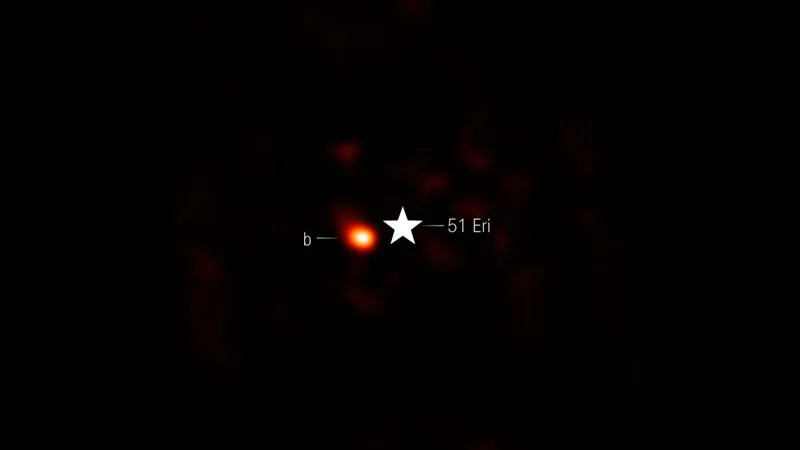
Groundbreaking Images of Exoplanets Captured by JWST’s Unconventional Techniques
2025-04-01
Author: Daniel
Astrophysicists recently made headlines with the release of stunning new images of exoplanets located in the HR 8799 and 51 Eridani star systems. This scientific breakthrough was achieved using the James Webb Space Telescope (JWST) in a carefree and unconventional manner, raising eyebrows in the astronomy community.
The lead author of the study, William Balmer, a Ph.D. candidate at Johns Hopkins University, explained in an interview how this pioneering approach marks a significant advancement in our understanding of exoplanets, their formation processes, and the ongoing search for extraterrestrial life.
“Direct imaging is vital for studying distant planets,” Balmer notes. “It provides valuable insights regarding their atmospheric structure and composition, independent of the blinding light emitted by their host stars.”
One of the trickiest aspects of direct imaging is differentiating the faint light from planets against the bright glare of their host stars. This challenge is exacerbated by the immense distances between us and these exoplanets, making high-quality images often out of reach for conventional telescopic methods.
Enter the JWST, equipped with advanced technology, including a large mirror and sensitive instruments designed to detect faint emissions from orbiting exoplanets particularly in the mid-infrared range. This capability has thrown open the doors to a new era in exoplanet research.
“By analyzing different gas compositions at various pressures and temperatures in a planet’s atmosphere, we can glean not only its elemental makeup but also insights about how these worlds came into existence,” Balmer elaborated.
In a daring move, Balmer and his team used the JWST’s coronagraphs in a nonstandard way, capturing images that others thought impossible. “We jokingly say we ‘used the coronagraphs wrong’, but what we actually did was exploit a thin section of the mask that allowed some starlight to circumvent the system,” he explained.
Originally developed in 1930 for solar studies, coronagraphs serve to block out starlight and reveal nearby celestial bodies. However, excessive light blockage can obscure even the exoplanets under assessment. Therefore, Balmer's team adjusted the coronagraph masks to fine-tune the amount of starlight blocked, maximizing the visibility of the planets.
Utilizing the remarkable stability of JWST, they compared images of their target systems to those of similar stars without known planets. This methodology effectively isolated the faint signals from the planets by subtracting the star’s light, leading to clearer images than ever before.
This study marks a monumental achievement, producing the first-ever images of HR 8799 at a wavelength of 4.6 microns—a region mostly blocked by Earth’s atmosphere, rendering ground-based observations nearly impossible. Balmer pointed out, “Previous attempts to image the HR 8799 e at these wavelengths were futile. Even though some ground-based telescopes have larger mirrors than JWST, our success showcases the paramount importance of JWST’s stability for such detections.”
Even more thrilling is the JWST’s ability to observe wavelengths completely rendered invisible by Earth’s atmospheric interference at 4.3 microns. “This is where we uncover hidden potentials,” Balmer added, noting that the atmospheric conditions on Earth stifle observations at this crucial wavelength.
Crucially, analyzing carbon dioxide levels can divulge essential information about a planet's formation. The dynamic between carbon monoxide and carbon dioxide in those exoplanet atmospheres signals the presence and abundance of heavier elements, which are pivotal for understanding their development. According to Balmer, the strong detection of carbon dioxide suggests that the HR 8799 planets likely have a rich inventory of heavy elements relative to their host star, implying they must have acquired these elements from their surroundings.
The findings do not stop there. The team also observed unexpected variations in the "colors" between the inner planets of the HR 8799 system. “Their appearances have often seemed quite uniform in near-infrared light,” Balmer remarked. However, the mid-infrared analysis allowed them to recognize differing molecular compositions, potentially reflecting different atmospheric dynamics or mineral compositions.
In this vein, the study also indicated that 51 Eridani b may exhibit less light than expected due to elevated levels of carbon dioxide and carbon monoxide. “This hints at a metal-rich core, akin to HR 8799,” Balmer said, explaining that atmospheric circulation may be moving these heavy gases into layers where they capture more outgoing light.
The broader implications of Balmer’s research extend to future observations and modeling. With 23 additional hours of JWST time secured to study four other planetary systems, the team aims to unlock further knowledge regarding how gas giants influence smaller terrestrial planets’ stability and habitability.
As we stand on the precipice of this “new frontier,” the revelations brought forward by innovative techniques exemplify the potential breakthroughs still waiting to be uncovered in the vast realm of the universe. Stay tuned as space exploration takes flight once more!

 Brasil (PT)
Brasil (PT)
 Canada (EN)
Canada (EN)
 Chile (ES)
Chile (ES)
 Česko (CS)
Česko (CS)
 대한민국 (KO)
대한민국 (KO)
 España (ES)
España (ES)
 France (FR)
France (FR)
 Hong Kong (EN)
Hong Kong (EN)
 Italia (IT)
Italia (IT)
 日本 (JA)
日本 (JA)
 Magyarország (HU)
Magyarország (HU)
 Norge (NO)
Norge (NO)
 Polska (PL)
Polska (PL)
 Schweiz (DE)
Schweiz (DE)
 Singapore (EN)
Singapore (EN)
 Sverige (SV)
Sverige (SV)
 Suomi (FI)
Suomi (FI)
 Türkiye (TR)
Türkiye (TR)
 الإمارات العربية المتحدة (AR)
الإمارات العربية المتحدة (AR)